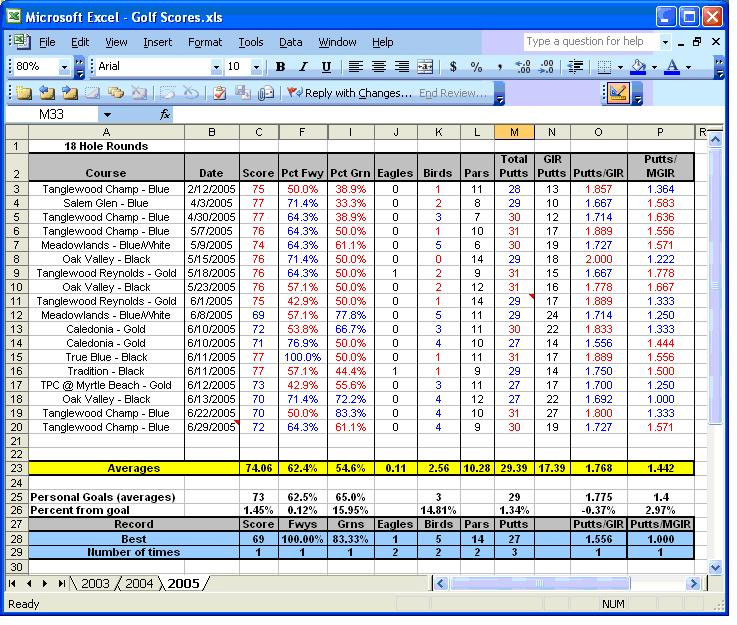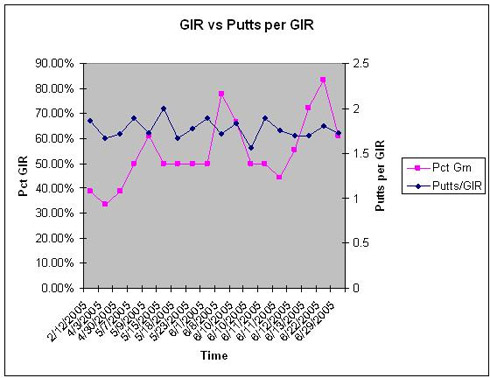Welcome to The Numbers Game. Over the following weeks I will try to extract some sense from all of the numbers in golf. There is more to golf than just +1, -1 or for the less fortunate, quad, triple, snowman… well, you get what I’m talking about. No need to bring those things up. I’m going to look at statistics such as Greens in Regulation (GIR), Driving Accuracy, Putts per GIR, etc. and others in future articles to dig deeper into the players on tour and how they are performing. I may extrapolate some data to make predictions or I may look into the history and leave the conclusions to you. Hopefully we’ll all have some fun doing it.
Who am I? Just a golf nut… and not unlike most people who are addictive in nature. I live in the great golfing state of North Carolina (by way of Pennsylvania… the weather drove me south). I’ve been playing golf since I was about 11 and have finally got my handicap down to 0. It only took me 20 years. I often add a couple to my handicap for mental deficiencies that come out during the course of play, but I’m probably preaching to the choir now, so I’ll move on.
I am a golf nut, but one who loves to look at stats. Growing up, I use to look through all the MLB box scores in the newspaper and follow who was leading in average, home runs, and ERA. It was always an attraction for me and something I always found interesting. Then the Internet came along.
Now you can get to-the-minute updates on everything. I started looking at golf statistics for the guys on tour. Here is a list of the commonly referred stats and what exactly they mean. The PGA’s official definition is in quotes.
Greens in Regulation – “A green is considered hit in regulation if any part of the ball is touching the putting surface and the number of strokes taken is 2 or less than par.” This is most commonly referred to as GIR. The “touching the putting surface” is an important distinction when we look at putting.
Driving Accuracy – “Driving Accuracy is the percent of time a player is able to hit the fairway with his tee shot.” It doesn’t matter if you use an iron, 3-wood or putter. If it is in the fairway after your first stroke, it counts as hitting a fairway. If you hit it OB and then put your third in the fairway, it doesn’t count.
Total Putts – “Putts per round is the average number of putts per round played.” Putts from the fringe do not count. This goes with the GIR comment above. If you putt it in from an inch off the fringe, you had 0 putts for the hole. Congratulations.
Putting Average – “Putting Leaders measures putting performance on those holes where the green is hit in regulation (GIR). For these holes, the total putts are divided by the total holes played. By using greens hit in regulation we are able to eliminate the effects of chipping close and one putting in the computation.” This is the stat used by the PGA tour and others to determine the best putter for the reason mentioned above.
Sand Saves – “Sand Saves is the percent of time a player was able to get ‘up and down’ once in a greenside sand bunker. Note: This up and down is computed regardless of score on the hole.” Doesn’t matter if it is for par or quad.
Scrambling – “This is the percent of time that a player misses the green in regulation, but still makes par or better.” This is a good short game stat that combines putting, sand and wedge play.
You can get other stats at PGA Tour.com. To find how they are computed, click on the stat you want and scroll to the bottom of the list. A definition is provided for each of them.
Keeping Stats
A while back I thought it would be a good idea to keep my own to review after a round. I didn’t start keeping my own seriously until a few years ago. For every round of golf I played, it initially started with just score, greens and fairways. It looked like this:
|
As you can see, this is nice and all, but not very complete. I wasn’t learning much from what I was recording. While I could see if I wasn’t hitting a lot of fairways or greens, I also had no target or goal for each statistic. Also, I couldn’t determine how I was truly putting. Sure, I had a putt total, but not the putts per GIR… the true putting stat used on tour. So I made some changes last year to look more like this:
|
This was better. It’s much more comprehensive and provided much more insight into what was going on with my game. Another area I added was “Goals.” I set a goal for myself with nearly every statistical category. I used was the number of the 75th place tour player of each category. How did I come to this? I’m not sure, but it’s close to the middle and seemed like a decent place to start. Also, the numbers looked attainable (granted I’m not playing PGA tour events and don’t plan to anytime soon).
Adding score after score, stat after stat, I started to see trends and areas that over time got better and worse. To highlight these trends I colored stats depending on whether it did not hit the target I wanted. Now the spreadsheet was looking good:

Click for a larger view.
With the coloring, it was easy to see that I wasn’t hitting greens very often early on in the year (red is bad if you didn’t notice… I hated seeing all those red marks on my papers in grade school). Once I started hitting more greens, I thought my putting stats would start to suffer. At that same time, I got a new putter (indicated by the comment in cell M11) and my putting improved as well. That is why my scores dropped. My irons improved as well as my putting and instantly I started making more birdies and lowering my scores.
One of the reasons I changed putters and worked so hard on my putting was directly related to this worksheet. My putts per GIR last year were 1.839. This would have been good enough to finish 194 out of 196 on tour. Maybe I should have said “bad enough.” I’ve spent about 3-4 days a week on the putting green at my home course working on my stroke. I’ve dropped total putts to 29.39 and putts per GIR to 1.768. I will say that the putts per GIR drop has been aided by hitting those better irons and getting the ball closer, but I know for a fact that I am also putting better.
All anyone needs to do to keep these stats is to mark four things per hole: your score, a check for fairway hit, a check for green hit, and putts. When you are done with the round, all of the statistics I’ve been talking about can be calculated. Set reasonable goals for yourself and make sure you address areas that are well below where you think they should be. You can add sand saves, up and downs, or any other stat that you want. Graphs also start to come easy. I created the graph below using the most basic of Excel graphs:

Start to keep your stats if you don’t already. It won’t take too much of your time and I think you’ll have fun doing it. If you’re not comfortable with Excel, there are plenty of golf statistics software packages available. I know for a fact it has helped my game and I hope it will help yours as well.

What is MGIR? (As in putts per MGIR)
I should have clarified. MGIR is a Missed Green in Regulation. I use it to see how well I’m getting up and down. It would be better to just track up and downs and sand saves…something I’m considering doing.
Hope that helps. Thanks for reading!
Hi Dave,
I have created a java blackberry / phone application ( http://wwww.wireless18.com ) that allows a golfer to record these stats whilst you play. The program then automatically caclulates all your percentages and graphs for you.
We are just upgrading the application (over the next few days) so thanks for this article as it has giving me good ideas for improvements. For one I reckon we need to add MGIR as currently we do not record ‘scrambling’ stats.
Comments (3)
Just joined the site, great work guys. I have enjoyed all of the reviews listed.
Thanks
Posted by: flkip at November 28, 2005 07:44 PM
Thanks for your test/review of the R5-N. I have noticed some of these clubs on ebay claim to have soft tip and some have firm tip shafts.I thought the R5-N only came with the firm tip.What gives? Which one did you test? If both are available what swings will work best for the respective tips?
Thanks in advance,Jack
Posted by: Jack Warren at November 29, 2005 06:33 AM
almedrahe lktronik yemen sava.a alcaerostraeet new unifirste p.o.box13508 til00967711783901 00967711334021 00967733013781 fax009671504664 abdualmohsn ahmad almedrahe abdualmohsn@hotmail.com almedrah_win94a@jackpot.com almedrah_win94a12@jackpot.com abdualmohsn_55l@yahoo.com houkan se mae accont tTO 2002/2006 ABDUALMOHSN AHMAD ALMEDRAJEYEMEN SANA.A P.O.BOX13508
Posted by: abdualmohsn ahmad almedrahe at January 30, 2006 01:24 PM
abdualmohsn ahmad almdrahe yemensana.a transfeer TO abdualmohsn yemen alcaerostraeet new unifyrste p.o.box13508
For fairways hit, how do you handle the par threes. Also, how do you calculate the scrambles with only the statistics you record. I could call all non GIR one putts a scramble. Is that it?
I’ve created my own spreadsheet and I’ve got a question. How do you handle putts when you putt it off the green? I’ve goggled this and seen some say once you hit the green all strokes are putts, and I’ve seen others say only strokes on the green are putts. The latter makes more sense to me but it screws up my calculating because it’s possible to hit a GIR and have a 2 putt bogey.
Your approach to tracking golf stats is impressive, blending detailed analysis with goal-setting. By focusing on key metrics like fairways, greens, and putts, and comparing them to PGA Tour benchmarks, you’re gaining valuable insights into your game. The use of color coding to track trends helps highlight areas for improvement, which should lead to continued progress. Keep up the great work!